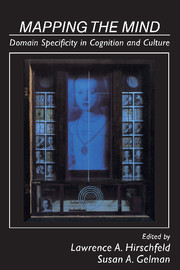Book contents
- Frontmatter
- Contents
- List of contributors
- Preface
- Part I Overview
- Part II The origins of domain knowledge: Biology and evolution
- Part III The origins of domain knowledge: Conceptual approaches
- Part IV Are domains theories?
- 10 The theory theory
- 11 Thinking by children and scientists: False analogies and neglected similarities
- 12 Core domains versus scientific theories: Evidence from systematics and Itza-Maya folkbiology
- 13 Essentialist beliefs in children: The acquisition of concepts and theories
- Part V Domains across cultures and languages
- Part VI Implications for education
- Author index
- Subject index
12 - Core domains versus scientific theories: Evidence from systematics and Itza-Maya folkbiology
Published online by Cambridge University Press: 04 August 2010
- Frontmatter
- Contents
- List of contributors
- Preface
- Part I Overview
- Part II The origins of domain knowledge: Biology and evolution
- Part III The origins of domain knowledge: Conceptual approaches
- Part IV Are domains theories?
- 10 The theory theory
- 11 Thinking by children and scientists: False analogies and neglected similarities
- 12 Core domains versus scientific theories: Evidence from systematics and Itza-Maya folkbiology
- 13 Essentialist beliefs in children: The acquisition of concepts and theories
- Part V Domains across cultures and languages
- Part VI Implications for education
- Author index
- Subject index
Summary
Introduction
This chapter is intended to be an anthropological contribution to two areas of central interest to this volume: (1) the nature of specific cognitive domains common to ordinary folk, and (2) the relationship between the structure of the most basic of these commonsense domains to the structure of corresponding scientific theories. The claim is that for one such domain – folkbiology – conceptual categories exhibit high internal cultural consensus, and significant cross-cultural correlation with scientific taxonomies. Still, this apparently panhuman and domain-specific taxonomic structure may be embedded in different belief systems and may be distinctly interpreted at various levels of expertise.
Because this categorical structure provides such strong constraints on theories, there should be at least some stability and cross-cultural consistency to theory-related inferences. For example, different cultures may have very different beliefs about reproduction; but if their judgments about whether or not two species could interbreed is based on taxonomic relatedness, then these judgments should show the same decreasing function of taxonomic relatedness. Moreover, if the structure of taxonomy is enough to generate “default” probabilities for inferences about any of its categories given any other of its categories, then an indefinitely large number of category-based inductions can be made within folkbiology without having to resort to any prior system of causal explanation (cf. Osherson, Smith, Wilkie, Lopez & Shafir, 1990; Osherson et al., 1991). Thus, we might expect both New Yorkers and Itza-Maya to find it more likely that wolves have sharp canines and eat “gravy train” than do mustangs, given that dogs have sharp canines and eat “gravy train.”
- Type
- Chapter
- Information
- Mapping the MindDomain Specificity in Cognition and Culture, pp. 316 - 340Publisher: Cambridge University PressPrint publication year: 1994
- 46
- Cited by



